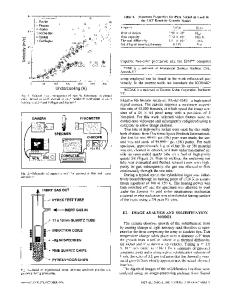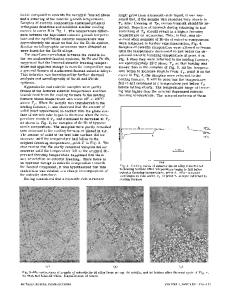The velocity of solidification of highly undercooled nickel
- PDF / 1,509,606 Bytes
- 8 Pages / 598.28 x 778.28 pts Page_size
- 93 Downloads / 372 Views
I.
INTRODUCTION
THE study of solidification velocity is useful for two reasons. First, the manner in which the degree of undercooling and solidification velocity affect the microstructure of the solid is fundamental. Second, there is disagreement on the relationship between the degree of undercooling of the liquid and the solidification velocity. Theory predicts monotonically increasing relationships between undercooling and interface velocity. However, discontinuities in behavior have been reported, tL2] In order to closely monitor the progression of the thermal field developed by recalescence in electromagnetically levitated nickel, a novel technique using a linear array of photodiodes has been employed. Of primary interest is the velocity of the solid/liquid interface at undercoolings greater than 10 pet of the equilibrium freezing point (TM), since present theories and experimental results diverge above this level. The results from this effort are compared to theoretical predictions and previously reported data, and the similarities and differences are discussed. II.
BACKGROUND
A. Radiance Methods of Measuring Solidification Velocity In opaque samples, the movement of the solidification front can be followed on the surface by monitoring the progression of the thermal field developed by recalescence if the ratio of the thermal diffusivity to the interface velocity is small. If such is the case, then the solid/ B. TIMOTHY BASSLER, Graduate Student in Materials Science, WILLIAM H. HOFMEISTER, Research Associate Professor of Materials Science, and ROBERT J. BAYUZICK, Professor of Materials Science, are with the Department of Applied and Engineering Sciences, Vanderbilt University, Nashville, TN 37235. GABRIEL CARRO, formerly Research Associate, Department of Applied and Engineering Sciences, Vanderbilt University, is Materials Engineer, TRW Commercial Steering Division, Lebanon, TN 37088. Manuscript submitted March 11, 1993. METALLURGICALAND MATERIALS TRANSACTIONSA
liquid interface is well defined by the thermal field due to recalescence. For liquid nickel, the thermal diffusivity is 12 x 10 -6 m 2 s-~, [3j so at a velocity of 10 m s -1, the ratio of the diffusivity to the interface velocity is 1.2 x 10 -4 m. This quotient indicates that the thermal field does not proceed ahead of the solidification front by a significant distance. Therefore, in these types of experiments, the solidification front can be tracked by the thermal field. In high-temperature systems, this can be accomplished by measuring the increase in output of a silicon photodiode focused on an area of the sample.
B. Solidification Velocity Measurements for Nickel Walkel4~1 made measurements of the growth velocity in undercooled nickel using two photodiodes spaced along a column of undercooled nickel. The velocity of the solid/liquid interface was calculated by dividing the distance between observation points by the time interval between the observation of recalescence by the two photodiodes. Temperature measurements were made with a thermocoup
Data Loading...










